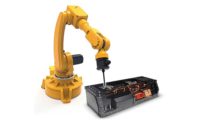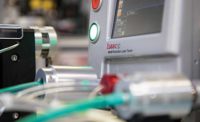A popular trope in detective novels is the “locked room mystery,” in which a murder is committed under seemingly impossible circumstances. The crime scene is a place—a locked room—that no intruder could have entered or left. Only a brilliant, determined detective can solve the mystery.
There’s an analogous situation in medical device manufacturing: How to leak-test an assembly, such as a pacemaker, that is hermetically sealed. With no inlets or outlets, there’s no direct way to get air or a tracer gas into or out of the device. Fortunately, assemblers don’t need Sherlock Holmes to solve this conundrum. They just need to consult an experienced supplier of leak testing technology.
“Hermetically sealed parts take a little more fixturing, but the test itself is pretty straightforward,” says Michael McKay, general manager of Vacuum Instrument Corp.
Two test chambers are needed. One chamber conforms to the shape of the assembly. The other is a reference volume. The two chambers are connected by a valve, and a leak-test instrument monitors the pressure inside the chambers.
To start the test, the assembly is placed inside the conformal chamber. Next, the reference volume is pressurized so that when the valve is opened, air flows into the conformal chamber. The reference volume should be pressurized just enough that the resulting equilibrium is the desired test pressure.
“At that point, the first thing we do is check to see if we have the nominal test pressure,” explains McKay. “If we don’t, that indicates a gross leak. Air has clearly leaked into the assembly.”
If the test pressure is achieved, the instrument monitors the pressure for a set period of time. The rate of air leaking into the assembly can then be calculated from the difference between the initial pressure and the final pressure.
If the assembly is small—the size of a large pill or a laser diode, for example—engineers can eliminate the reference volume and simply reduce the size of the conformal chamber by a set amount during the test. Decreasing the volume, obviously, will increase the air pressure inside the chamber. If the desired test pressure is not achieved, then air has leaked into the assembly.
“If the free volume [inside the conformal chamber] is less than 1 cc, you can get a leak-rate sensitivity in the range of helium mass spectrometry with hermetically sealed parts,” says McKay, whose company recently designed just such a system to test a pill-sized video camera for examining the digestive tract.
If the leak rate specification is very low—10-9 cc per second—assemblers have no choice but to use helium as a tracer gas. The problem then becomes how to get the helium inside the device. Laco Technologies Inc. faced just such an issue when it was tasked to design a system to leak-test a tiny, hermetically sealed ocular implant.
The company’s solution was simple, yet elegant. The implant is assembled up to the point at which a laser welds the case together, creating the hermetic seal. The implant is placed in a small vacuum chamber. The air inside the chamber is evacuated and replaced with helium. A laser, located outside the chamber, then welds the case together through a window, trapping helium inside the assembly.
At that point, the chamber is evacuated again and connected to a mass spectrometer, says Paul Chamberlain, president of Laco Technologies. If the instrument detects helium, it must therefore be leaking from the implant.
Leak Testing Challenges
From catheters and cannulae to aspirators and dialysis filters, almost all medical devices are tested for leaks. Thankfully, most medical devices are not quite as challenging to test as ocular implants and swallowable cameras. In most cases, medical devices do not need to meet stringent leak rate requirements. As a result, they can often be tested with air-based methods, such as pressure decay and mass flow.
“Mass flow is a good technique for leak-testing medical devices,” says McKay. “It’s inexpensive. It gives you a direct read-out in cubic centimeters per minute. And, it detects gross leaks quickly.”
While they may not share the same leak rate specifications as, say, the fuel rail of an engine or the evaporator coils in an air-conditioner, medical devices do present some unique challenges to suppliers of leak testing equipment. For example, because medical device assemblers must adhere to the FDA’s good manufacturing practice guidelines, test speed and production rate are typically less of a concern than repeatability, quality and documentation.
To meet the latter requirement, data storage and networking are critical, says Gordon D. Splete, marketing director for Cincinnati Test Systems Inc. His company’s latest instrument, the Sentinel Blackbelt Pro, can store 1 million test results in its onboard memory. Test data can be serialized and transmitted via RS-232, Ethernet or USB ports.
Cleanliness is also important. Test fixtures are made from stainless steel, and test air is filtered to keep out contaminants. Although medical devices are typically sterilized after the assembly and test process, there are exceptions. For example, single-use bioprocess bags are often leak-tested twice—once by the manufacturer before sterilization and again by the customer after sterilization. Made of flexible plastic, the bags are assembled with a heat-welding process. Numerous tubes and bulkheads are attached.
“Because the product has already been sterilized, a sterile-grade filter has to be put on the gas or air supply line,” explains Chamberlain. “The filter traps any particle larger than 0.2 micron to ensure that the leak test cannot introduce bacteria into the container.”
The bags can be tested with either the pressure decay method or helium mass spectrometry.
“The challenge for leak testing is that some of these bags are very large. Some can hold hundreds of liters,” says Chamberlain. “The pressure-decay method is volume dependent, so with very large bags, it’s less sensitive. Environmental factors can affect the test. Helium testing allows us to find leak paths as small as 5 microns wide.”
Holding the Bag
Another unique aspect of medical devices is that many of them are made from flexible materials. Every leak testing method is based on creating or reducing gas pressure inside or outside an assembly. However, if you pressurize a blood bag, for example, it will simply expand like a balloon. Pressurize it too much, and it will burst. Pull a vacuum on it, and it will collapse.
To solve that problem, test pressures are minimized, and ridged or porous plates are used to restrain the assembly while it is pressurized, says Splete. The plates keep the bag at a consistent volume, while the ridges or pores allow gas to escape from potential leak paths.
Another option, at least for sealed packages, is to place the package in a sealed chamber and reduce the pressure by a small amount, says Jacques Hoffmann, president of InterTech Development Corp. As the pressure drops, the package will expand as the air inside seeks equilibrium. A laser displacement sensor can measure how much the package expands. If the package doesn’t expand or fails to hit a certain expansion threshold, it must be leaking.
Catheters are another tricky assembly for leak testing. They are long, thin and flexible. Some have multiple lumens. Thus, the test instrument must not only check that the catheter doesn’t leak to the outside, but it must also check for leaks between lumens.
In a basic setup, one lumen of the catheter is connected to the leak test instrument, while the other end is blocked. The instrument then supplies pressurized air into that lumen. If air flows into the lumen, there must be a leak to the outside or between the lumens. Many leak detectors are equipped with valve controllers that enable seals to be opened and closed during a test cycle to individually test multiple lumens.
Good Advice
As with any assembly and test project, it’s wise to consult a leak testing supplier as early as possible. “Understanding the characteristics of the part you’re going to test, including its mechanical properties, is critical to successful leak testing,” says Chamberlain. “Proper fixturing and constraining of the parts goes a long way toward improving sensitivity and repeatability. We frequently ask customers for a few sample parts that we can test in our lab so we can assess those challenging nuances. Often, those can’t be predicted by looking at a drawing or a solid model of the part.”
Many suppliers can help manufacturers with more than just leak testing. An occlusion test can find blockages created during welding or bonding. A flow test can assess how well a device transmits a gas or liquid. If the device is designed to deliver a specific volume or dose, a test instrument can measure that. A device with a check valve can be tested for cracking pressure, or the minimum upstream pressure at which the valve will operate. Electrical testing can be done on devices with integrated pressure transducers. Burst testing—a destructive test—can be done to assess the strength of seals and packaging.
“Pick a vendor with experience integrating fixturing, testing and automation,” advises Hoffman.









